Cirsium ochrocentrum, Yellowspine Thistle
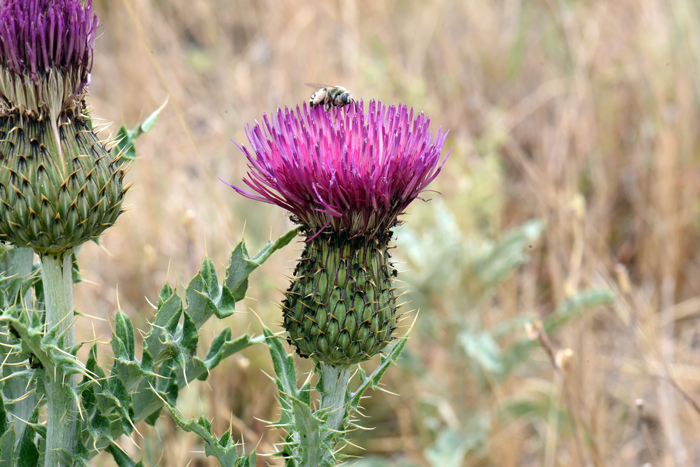
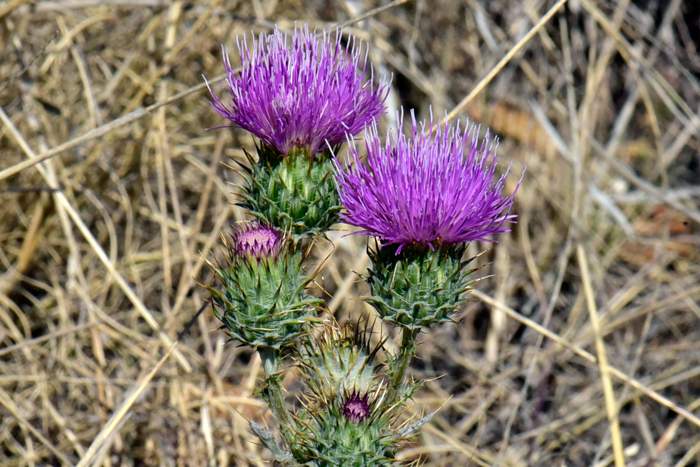
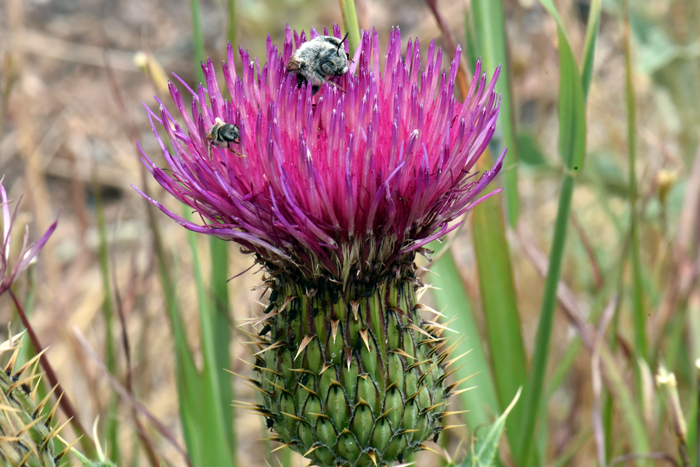
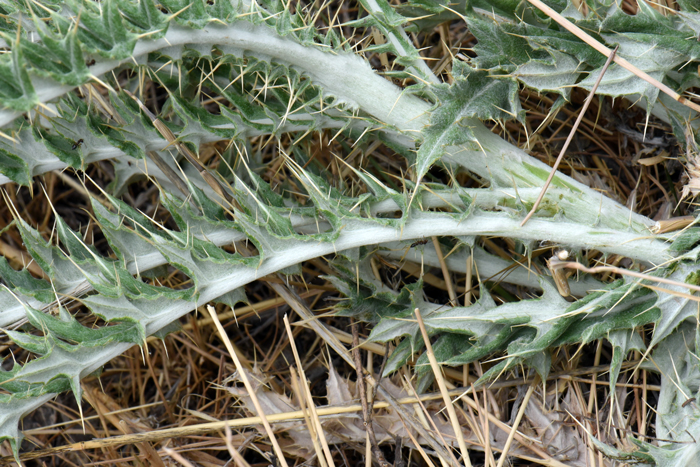
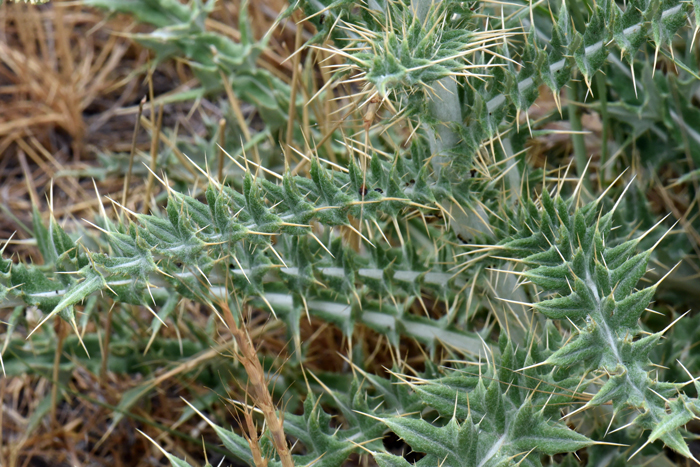
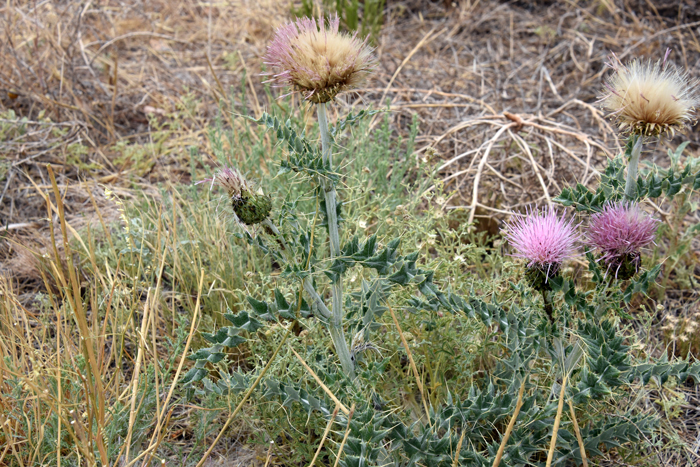
Scientific Name: Cirsium ochrocentrum
Common Name: Yellowspine Thistle
Also Called: Spanish: Cardo
Family: Asteraceae, Sunflower Family
Synonyms: (Carduus ochrocentrus, Carduus undulatus var. undulatus, Cnicus ochrocentrus, Cnicus undulatus var. ochrocentrus )
Status: Native
Duration: Biennial or perennial.
Size: Up to 3 feet (30-90 cm)
Growth Form: Forb/herb stems 1 to 20, erect or ascending; stems densely gray-tomentose.
Leaves: Grayish-white tomentose; alternate, leaf shape variable, oblong to narrowly elliptic, strongly undulate; leaf edges or margins coarsely dentate or shallowly to deeply pinnatifid with 8 to 15 pairs of lobes; lobes-tipped with strong spines, main spine sharp and yellowish; lower leaf surfaces white-tomentose, upper leaf surfaces grayish-tomentose.
Flower Color: Pink, purple, white or lavender; heads solitary or few, flowering stalk (peduncle), bracts or phyllaries around floral heads linear or lanceolate always with sharp yellow spines; fruit a light brown cypsela.
Flowering Season: April, May or June to July and October
Elevation: 4,500 to 8,000 feet (1,370-2,430 m)
Habitat Preferences: Open areas, disturbed areas, grasslands, pinyon-juniper communities, fields, roadsides.
Recorded Range: Yellowspine Thistle has a large geographic range, generally in the western half of the United States including the Great Plains of the Central United States and the desert regions of the southwestern United States. It is also native to much of northern Mexico southward to include Durango.
North America & US County Distribution Map for Cirsium ochrocentrum.
North America species range map for Cirsium ochrocentrum:
North American range map courtesy of Virginia Tech, Dept. of Forest Resources & Environmental Conservation

Plants included here may become weedy or invasive. See Comments: section below for additional information regarding “weedy” thistles.
Invasive/Noxious Weed Information: In North America Cirsium ochrocentrum is listed as a noxious weed by the States of:
Plants included here are invasive or noxious. See the Comments: section below for additional information regarding “noxious” thistles.
Wetland Indicator: Unknown
Threatened/Endangered Information: Unknown
Genus Information: In North America there are 91 species for Cirsium. Worldwide, The Plant List includes 481 accepted species names and a further 812 scientific names of infraspecific rank for the genus.
The genus Cirsium was published by Philip Miller in 1754.
In the Southwestern United States: Arizona and New Mexico each have 19 species of genus, California has 26 species, Nevada has 16 species, Texas has 12 species, Utah has 23 species. All data approximate and subject to revision.
There are 2 sub-species of Cirsium ochrocentrum;
Cirsium ochrocentrum ssp. martinii, (AZ, NM);
Cirsium ochrocentrum ssp. ochrocentrum, generally western half of the United States.
Comments: Yellowspine Thistle is a common upland thistle in Arizona at elevations above 4,500 feet.
The genus Cirsium in general, has received adverse notoriety because of the introduction of two thistles native to Europe and now widespread throughout North America. The Canadian Thistle, Cirsium arvense and and the Bull Thistle, Cirsium vulgare are both listed as noxious primarily by agricultural interests. The Canadian Thistle and Bull Thistle together for example are listed as noxious weeds in 33 and 9 states respectively.In reality, most southwestern native thistles, including Graham's Thistle, are non-aggressive; non-invasive and beneficial as pollinators. Our native thistles have evolved over thousands of years and have mostly thrived without ever becoming weedy. However, many native thistles are now threatened and some species are at risk of extinction.
In Southwest Desert Flora also see; Arizona Thistle, Cirsium arizonicum, Graham's Thistle Cirsium grahamii, Mojave Thistle, Cirsium mohavense and New Mexico Thistle, Cirsium neomexicanum.
For an interesting article on native thistles in North America see Native Thistles: A Conservation Practitioner's Guide, published on-line by The Xerces Society, For Invertebrate Conservation. To find out more about Butterflies and Moths of North America visit BAMONA.
Thistles of the genus Cirsium are known as “plume thistles” because they have feathered hairs on their pappi while thistles of the genera Carduus, Silybum and, Onopordum have a pappi with simple unbranched hairs.
The genus Cirsium was published by Philip Miller in 1754.
The species epithet ochrocentrum (ochrocen'trum:) means with an ochre-colored center.
See complete listing of ethno-botanical uses at Native American Ethnobotany, University of Michigan, Dearborn.

